|
 he Henry Ford
Museum and its adjacent Greenfield Village in
Dearborn, MI were conceived by
Henry Ford himself as a learning institution where Americans could learn how their
ancestors lived and worked in the past
– specifically Henry Ford's past,
the latter half of the nineteenth century and early portion of the
twentieth. Ford believed that the precepts he had learned growing up in
rural and small town Midwest America was responsible for his success and
that of other Americans such as Thomas Edison, George Washington Carver,
and the Wright brothers. Edison himself signed the cornerstone of
the "Edison Institute," as it was originally known, in 1928. Then Ford began to fill the 8-acre building with what, at the time, many
considered flea market fodder. Today, of course, they are priceless
relics. he Henry Ford
Museum and its adjacent Greenfield Village in
Dearborn, MI were conceived by
Henry Ford himself as a learning institution where Americans could learn how their
ancestors lived and worked in the past
– specifically Henry Ford's past,
the latter half of the nineteenth century and early portion of the
twentieth. Ford believed that the precepts he had learned growing up in
rural and small town Midwest America was responsible for his success and
that of other Americans such as Thomas Edison, George Washington Carver,
and the Wright brothers. Edison himself signed the cornerstone of
the "Edison Institute," as it was originally known, in 1928. Then Ford began to fill the 8-acre building with what, at the time, many
considered flea market fodder. Today, of course, they are priceless
relics.
Legend has it that Ford set out to buy "one of everything made in
America" from the Edison Institute's target time period and by all
appearances, he very nearly succeeded. In addition to a word-class
collection of historic automobiles, there is also a dazzling array of
bicycles, plows, canning jars, saw mills, electric fans, steam engines,
rocking chairs, early airplanes and other flotsam and jetsam from the Good
Old Days. The present staff has expanded the original time period to
include all of America's past. You will, for example, find a 1952 Oscar
Meyer Weinermobile, a 1960 McDonald's Hamburger marquee, as well as relics
from Colonial America. It is as complete a picture of American culture as has
ever been assembled. The Institute opened in 1929 with Thomas Edison,
Orville Wright, and other notable American scientists and engineers in
attendance.
Not content just with artifacts, Ford also collected buildings and
resurrected them in a "village" on an 81-acre tract next to the
museum. Greenfield Village consists of 84 historic structures that
were built in different parts of the United States at different time
periods, providing life-size snapshots of homespun American architecture
and industry. Originally, the village was intended as a hands-on classroom
where students could learn both old and new technical skills and the
original school operated until 1969, sometimes hosting over 200
students. In fact, there's a charter school of 400 students on the
museum campus with an educational mission very much like the original.
But Ford also opened the village to the public in 1933.
Some of the buildings in the village are the homes and workshops of the
people who invented modern America – Ford's old Michigan homestead is
there, along with Edison's New Jersey laboratories, and
– of course
–
the Wright brother's home and bicycle shop.
Acquiring
the Wright Stuff
One of the many things made in America that Ford had tried to buy for
his museum was the 1903 Wright Flyer. He had approached Orville about
purchasing it in 1925, when he learned that Orville was thinking of
sending it to the Kensington Science Museum in London. Orville had said
he would do this to protest the
Smithsonian's continued promotion of the 1903 Langley Aerodrome as the first
airplane "capable" of manned flight. Orville turned
Ford down; he had already committed to Kensington.
Henry Ford decided to try again in late 1935 at the
urging of William E. Scripps, editor of the Detroit News and a
member of the Early Birds of Aviation (pilots who had learned to fly
before World War I). Scripps and Ford sent the Detroit News
aviation editor, James Piersol, to talk to Orville about bringing
the Flyer back from England and installing it in the Henry Ford
Museum. Orville once again refused, but was interested when Piersol
proposed that he help facilitate the movement of the old Wright
Cycle Company building to Greenfield Village to become part of the
Greenfield Village "walking museum." Piersol invited Orville to visit Greenfield Village in the summer
of 1936 and five days after his visit, the Wright's old landlord, Charles Webbert, sold the old shop building at 1127 West Third Street to
Piersol for
$13,000. Piersol immediately donated it to Ford's Edison Institute. Several
of Dayton's residents raised a fuss when the Dayton Daily
News broke the story on 4 July 1936. Judge James Douglas of the Court
of Common Pleas wrote, "It is an outrage to let a thing like this
happen. First England takes the first airplane and now Henry Ford
takes the original workshop…"
Most of Dayton, however, remained as uninterested in the matter as they
had when the Wrights were making their first flights at Kitty Hawk and
Huffman Prairie. Henry Ford, his son Edsel, and Fred Black, the director
of Greenfield Village, swooped down from Dearborn that October. While
talking to Orville about removing the bicycle shop, they found that the
old home at 7 Hawthorne Street might also be available. A month later,
they bought it from Lottie Jones, the Wright's former washerwoman, for
$4,100. By February of 1937, both the shop and the house had been removed
to Michigan. Henry Ford even took 20 tons of dirt on which the house stood, and
the hole in the ground on Hawthorn Street remained for many years.
Restoring
the Home and Shop
At Greenfield Village, both the house and the shop were placed side by
side. (In Dayton, they had been a few blocks apart.) Curators restored
them as nearly as possible to their appearance in 1903, when the Wrights
made their first powered flight. Ford's people looked high and low for
Charlie Taylor, the
Wright's mechanic and the builder of their first airplane motors. They
finally traced him to California
where he was working as a machinist for North American Aviation for 65
cents an hour. The Edison Institute hired him as a consultant to oversee the restoration
of the shop. Charlie, working with Orville's secretary, Mabel Beck,
tracked down most of the machine tools they had used in the shop. What he
couldn’t find, Charlie made, including a natural gas engine that he had
helped the
Wrights to make in 1901. It had powered their lathe, drill press, grinder
– and wind tunnel!
Orville and Lottie Jones gathered items for the house, including some
pieces of furniture that he and Wilbur had made. For some time, Lottie
kept "discovering" things that had belonged to the Wrights and
sending them up to Greenfield Village with requests for payment. Fred
Black was amenable, but he didn't want her to continue milking the Edison
Institute indefinitely. He finally confronted Lottie and demanded a
complete list of the items she had so he could arrive at a final financial
settlement.
The restored house and bicycle shop opened on Wilbur's birthday, 16
April 1938. Charles Kettering, inventor of the automotive self-starter and a
friend of the Wrights, presided over the ceremony. Several pioneer
aviators, including Frank Lahm and Walter Brookins (both of whom the
Wrights taught to fly), also attended.
Up for a virtual expedition? With each of these locations we offer
the option "Click HERE to visit..." This is a link to a KMZ
file or placemark in Google Earth. When you click on the
link, a box will appear asking is you want open, save, or cancel the
file. Choose "Open" to run Google Earth and view the file
immediately. Choose "Save" if to save the placemark and view it
later. Note: You must have Google Earth installed to follow the
placemark. If you do not already have Google Earth installed,
go HERE.
|
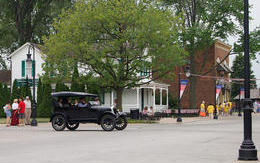
The Wright brothers home and bicycle shop as it appears now in
Greenfield Village at the Henry Ford Museum.
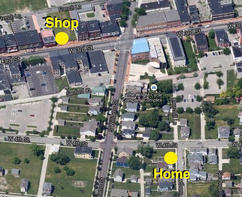
Overview of west Dayton, showing the former locations of the Wright
home and bicycle shop.
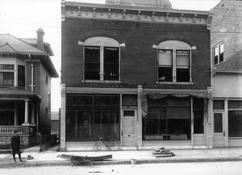
The Wright brothers bicycle shop in Dayton as it once stood at 1127
West Third Street.
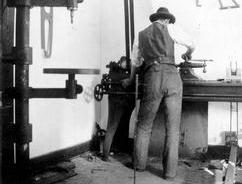
Wilbur at work in the back room of the Wright bicycle shop.
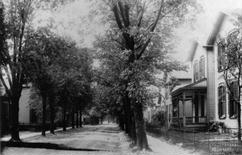
Hawthorn Street in West Dayton, looking south. The Wright home is on
the right, second house down.
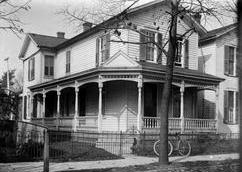
The Wright Home as it once stood at 7 Hawthorn Street. Note the
bicycle leaning against the fence.
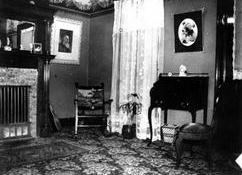
The Wright's parlor at 7 Hawthorn Street.
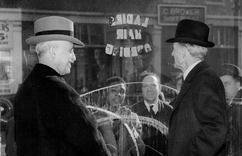
Orville Wright (left) and Henry Ford (right) standing at the window
of 1127 West Third Street in Dayton in 1936, prior to Ford moving
the building to Michigan.

The Wright brothers' restored home and workshop in Greenfield
Village, Dearborn, Michigan, in 1938.
|
Wright Home
|
Milton Wright and his wife Susan purchased their home at
7 Hawthorn Street in West Dayton in 1870 while it was still
under construction. Milton had arrived in Dayton, OH the
previous year when the Church of the United Brethren had
appointed him the editor of the church newspaper, the
Religious Telescope. The paper was published out of the
United Brethren headquarters in Dayton. Milton and Susan
moved their family into the house when it was completed in
1871. It was here that Orville was born on 19 August 1871.
His sister Katharine, the last of the Wright children, was
also born here exactly three years later on 19 August 1874.
In 1877, Milton was elected to the post of Bishop in his
church and assigned to oversee all the United Brethren
congregations between the Mississippi River and the Rocky
Mountains. In 1878, he moved his family to Cedar Rapids, IA
and the house at 7 Hawthorne Street was rented in the event
that the Wright family might return to Dayton
– Milton knew that his
position and responsibilities in his church would change
with United Brethren politics. He was relieved of his
Bishop's post in 1881 and reassigned as a preacher in
Indiana. The family moved to Richmond, IN that same year,
and then back to Dayton, OH in 1884. Brothers Reuchlin and
Lorin had left to start families of their own by this time,
but Milton, Susan, Wilbur, Orville, and Katharine remained.
The house at 7 Hawthorn Street was still occupied, so the
Wrights temporarily rented a residence on Summit Street
until their renters could find a place to move. When they
did, the Wrights moved in to stay for several decades.
Wilbur and Orville used their considerable skill with
tools to improve the house over the years they lived there.
They built a stylish front porch, complete with turned posts
and "Carpenter Gothic" decoration. They both built and
Wilbur hand-carved a handsome staircase from black cherry
hardwood. They also built some of the furnishings inside the
home.
Susan died in 1889 and Milton became sole owner, but in
1901 the property changed hands. Milton had sold some land
that he had bought while he lived in Iowa and he split the
money between his four sons. Instead of sharing in the
proceeds, daughter Katharine received the deed to the home
at 7 Hawthorn Street and the family remained in place. It
wasn't until Wilbur and Orville achieved considerable
financial success with their airplane business that the
Wright family thought of living somewhere else. In early
1912, the Wrights purchased 17 acres in nearby Oakwood
township and began to build a mansion called
Hawthorn Hill. Wilbur died before the new home was
finished, but the remaining members of the family
– Milton, Orville, and
Katharine – moved in
1914. Katharine sold the house at 7 Hawthorn Street to her
laundry woman, Lottie Jones, for $4,000.
-
CLICK
HERE to visit the original location of the
Wright Home in Google Earth.
-
CLICK
HERE to visit the the Wright Home at Greenfield
Village in Google Earth.
|
|
View the Wright Home in a larger map
\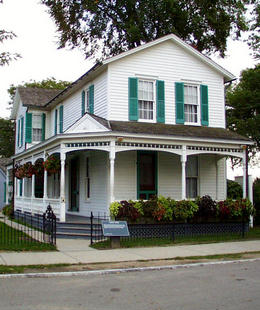
The restored Wright home is just east of the Wright Cycle
Company in Greenfield Village. It rests on 20 tons of dirt
taken from its original location at 7 Hawthorn Street in
Dayton, Ohio. This was common for many of the buildings in
Greenfield Village after Thomas Edison told Ford that he
felt that his Menlo Park Laboratories "should always stand
on New Jersey soil." Ford honored Edison's wishes by moving
the buildings and the soil.
|
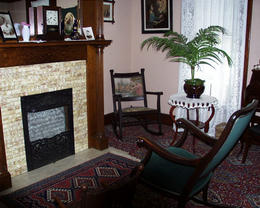
The Wright parlor at the front of the house. It's said that
Orville won the rocking chair (in the corner) in a bicycle race.
|
|
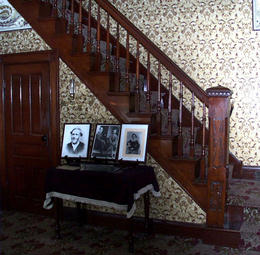
The ornamental staircase was built by the Wright brothers
– Wilbur carved the
newel post.
|
|
|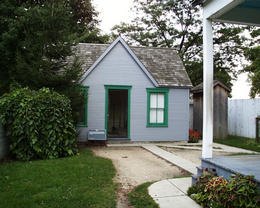
The Wright's back yard. The small storage shed doubled as
their darkroom for developing and printing photographs. This is
also where Will
and Orv stored the pieces of the 1903 Flyer after returning
from Kitty Hawk.
|
|

